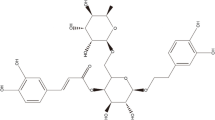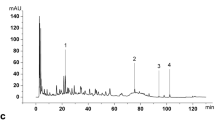Abstract
The purpose of this study is to investigate the anti-inflammatory effect of thalidomide (Thd) on H1N1-induced acute lung injury in mice. BALB/C mice were infected intranasally with influenza A virus (H1N1) and then treated with Thd at a dose of 100 or 200 mg/kg/day for 7 days. Weight loss and survival of mice were monitored for 14 days after virus challenge, and the serum and lung tissues were collected at 4 days for histological and biochemical analysis. The results showed that Thd significantly improved the survival rate, reduced the infiltration of inflammatory cells and cytokine (e.g., IL-6, TNF-α) and chemokine (e.g., RANTES, IP-10) levels, and inhibited activated p-NFκB p65 in infected mice. These findings suggested that Thd may attenuate H1N1-induced pulmonary injury and thus may find use in the treatment of viral diseases.







Similar content being viewed by others
References
Martinez-Hernandez, F., D.E. Jimenez-Gonzalez, A. Martinez-Flores, G. Villalobos-Castillejos, G. Vaughan, S. Kawa-karasik, A. Flisser, P. Maravilla, and M. Romero-Valdovinos. 2010. What happened after the initial global spread of pandemic human influenza virus a (h1n1)? A population genetics approach. Virology Journal 7: 196.
Yang, F., W.L. Zhou, A.L. Liu, H.L. Qin, S.M. Lee, Y.T. Wang, and G.H. Du. 2012. The protective effect of 3-deoxysappanchalcone on in vitro influenza virus-induced apoptosis and inflammation. Planta Medica 78: 968–973.
Julkunen, I., K. Melen, M. Nyqvist, J. Pirhonen, T. Sareneva, and S. Matikainen. 2000. Inflammatory responses in influenza a virus infection. Vaccine 19(suppl 1): s32–s37.
Amirshahrokhi, K. 2013. Anti-inflammatory effect of thalidomide in paraquat-induced pulmonary injury in mice. International Immunopharmacology 17: 210–215.
Martinez-Ocana, J., A. Olivo-diaz, T. Salazar-Dominguez, J. Reyes-Gordillo, C. Tapia-Aquino, F. Martinez-Hernandez, M.E. Manjarrez, M. Antonio-Martinez, A. Contreras-Molina, R. Figueroa-Moreno, R. Valdez-Vazquez, S. Kawa-Karasik, P. Rodriguez-Zulueta, A. Flisser, P. Maravilla, and M. Romero-Valdovinos. 2013. Plasma cytokine levels and cytokine gene polymorphisms in Mexican patients during the influenza pandemic a(H1N1)pdm09. Journal of Clinical Virology 58: 108–113.
Desanctis, J.B., M. Mijares, A. Suarez, R. Compagnone, J. Garmendia, D. Moreno, and M. Salazar-Bookaman. 2010. Pharmacological properties of thalidomide and its analogues. Recent Patents on Inflammation & Allergy Drug Discovery 4: 144–148.
Zhou, S., F. Wang, H. Tze-Chen, J.M. Wu, and E. Wu. 2013. Thalidomide-a notorious sedative to a wonder anticancer drug. Current Medicinal Chemistry 20: 4102–4108.
Wang, J.X., J.Y. Zhou, Q.W. Yang, Y. Chen, X. Li, Y.A. Piao, and H.Y. Li. 2008. An improved embryonated chicken egg model for the evaluation of antiviral drugs against influenza a virus. Journal of Virological Methods 153: 218–222.
Cheung, C.Y., L.L. Poon, A.S. Lau, W. Luk, Y.L. Lau, K.F. Shortridge, S. Gordon, Y. Guan, and J.S. Peiris. 2002. Induction of proinflammatory cytokines in human macrophages by influenza a (h5n1) viruses: a mechanism for the unusual severity of human disease? Lancet 360: 1831–1837.
Humphreys, I.R., G. Walzl, L. Edwards, A. Rae, S. Hill, and T. Hussell. 2003. A critical role for OX40 in T cell-mediated immunopathology during lung viral infection. Journal of Experimental Medicine 198: 1237–1242.
Matsukura, S., F. Kokubu, H. Kubo, T. Tomita, H. Tokunaga, M. Kadokura, T. Yamamoto, Y. Kuroiwa, T. Ohno, H. Suzaki, and M. Adachi. 1998. Expression of RANTES by normal airway epithelial cells after influenza virus A infection. American Journal of Respiratory Cell and Molecular Biology 18: 255–264.
Bradley-Stewart, A., L. Jolly, W. Adamson, R. Gunson, C. Frew-Gillespie, K. Templeton, C. Aitken, W. Carman, S. Cameron, and C. Mcsharry. 2013. Cytokine responses in patients with mild or severe influenza A (H1N1)pdm09. Journal of Clinical Virology 58: 100–107.
Wang, W., P. Yang, Y. Zhong, Z. Zhao, L. Xing, Y. Zhao, Z. Zou, Y. Zhang, C. Li, T. Li, C. Wang, Z. Wang, X. Yu, B. Cao, X. Gao, J.M. Penninger, X. Wang, and C. Jiang. 2013. Monoclonal antibody against CXCL-10/IP-10 ameliorates influenza A (H1N1) virus induced acute lung injury. Cell Research 23: 577–580.
Bernasconi, D., C. Amici, S. La Frazia, A. Ianaro, and M.G. Santoro. 2005. The IkappaB kinase is a key factor in triggering influenza a virus-induced inflammatory cytokine production in airway epithelial cells. Journal of Biological Chemistry 280: 24127–24134.
Flory, E., M. Kunz, C. Scheller, C. Jassoy, R. Stauber, U.R. Rapp, and S. Ludwig. 2000. Influenza virus-induced NF-kappaB-dependent gene expression is mediated by overexpression of viral proteins and involves oxidative radicals and activation of IkappaB kinase. Journal of Biological Chemistry 275: 8307–8314.
Ludwig, S., and O. Planz. 2008. Influenza viruses and the NF-kappaB signaling pathway—towards a novel concept of antiviral therapy. Biological Chemistry 389: 1307–1312.
Kumar, V., and S. Chhibber. 2011. Thalidomide: an old drug with new action. Journal of Chemotherapy 23: 326–334.
Acknowledgments
This work was supported by the National Natural Science Foundation of China (Grant No. 81173173).
Author information
Authors and Affiliations
Corresponding author
Rights and permissions
About this article
Cite this article
Zhu, H., Shi, X., Ju, D. et al. Anti-Inflammatory Effect of Thalidomide on H1N1 Influenza Virus-Induced Pulmonary Injury in Mice. Inflammation 37, 2091–2098 (2014). https://doi.org/10.1007/s10753-014-9943-9
Published:
Issue Date:
DOI: https://doi.org/10.1007/s10753-014-9943-9




